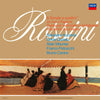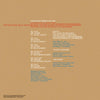



Rossini - Sonate a Quattro - Salvatore Accardo & Sylvie Cazeau (2LP, Box set, DMM)
Gioachino Rossini - Sonate a Quattro
Salvatore Accardo, Violin
Sylvie Cazeau, Violin
Alain Meunier, Cello
Franco Petracchi, Contrabass
Bruno Canino, Piano
2LPs, Box set
Original analog Master tape : YES
Direct Metal Mastering (DMM)
Heavy Press : 180g Virgin vinyl
Record color : Black
Speed : 33RPM
Size : 12'’
Stereo
Studio
Record Press : Pallas (Germany)
Label : Analogphonic
Original label : Decca
Recorded in October 1978
Direct Metal Mastering by Hans-Jörg Maucksch at Pauler Acoustics
Originally released in 1979
Reissued in 2015
Tracks :
Side A
- No.1 in G - Moderato
- No.1 in G – Andantino
- No.1 in G - Allegro
- No.2 in A - Allegro
- No.2 in A – Andantino
- No.2 in A - Allegro
Side B
- No.3 in C – Allegro
- No.3 in C – Andante
- No.3 in C – Moderato
- No.4 in B flat - Allegro vivace
- No.4 in B flat – Andantino
- No.4 in B flat - Allegretto
Side C
- No.5 in E flat - Allegro vivace
- No.5 in E flat – Andantino
- No.5 in E flat - Allegretto
- No.6 in D - Allegro spiritoso
- No.6 in D - Andante assai
- No.6 in D - Tempesta (Allegro)
Side D
- Duetto per violoncello e contrabbasso – Allegro
- Duetto per violoncello e contrabbasso - Andante molto
- Duetto per violoncello e contrabbasso - Allegro
- Un mot à Paganini
- Une larme pour basse : per contrabasso e pianoforte
Direct Metal Mastering
In Direct Metal Mastering, the cutting lathe engraves the audio signal directly onto a copper-plated master disc, instead of engraving the groove into a lacquer-coated aluminum disc.
The direct metal mastering technology addresses the lacquer mastering technology's issue of pre-echoes during record play, caused by the cutting stylus unintentionally transferring some of the subsequent groove wall's impulse signal into the previous groove wall. In particular, a quiet passage followed by a loud sound often clearly revealed a faint pre-echo of the loud sound occurring 1.8 seconds ahead of time (the duration of one revolution at 33 rpm). This problem could also appear as post-echo, 1.8 seconds after a peak in volume.
Another improvement is noise reduction. The lacquer mastering method bears a higher risk of adding unwanted random noise to the recording, caused by the enclosure of small dust particles when spraying the silvering on the lacquer master, which is the necessary first step of the electroplating process for reproduction of the master disc. As the DMM master disc is already made of metal (copper), this step is not required, and its faults are avoided.
With the groove being cut straight into a metal foil, this removed a number of plating stages in the manufacturing process. This gave rise to more upper frequency levels and less surface noise. Additionally, groove pre-echo problems are significantly diminished. Bass is typically tight and well defined, even described as more accurate than the fat, mushy sound of lacquered vinyl pressings.
Ratings:
Discogs : 4.58 / 5

